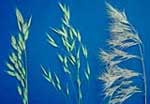|
|
Common weeds in Wheat cropping Systems
Botanical Name |
Hindi Name |
English Name |
Type |
Phalaris minor |
Gahu Ka Mama |
Little Seed Canary Grass |
Grassy |
Phalaris arundinacea |
Gahunsa |
Canary Grass |
Grassy |
Avana fatua |
Janglee Jai |
Wild Oat |
Broadleaf |
Convolvulus arvensis |
Hiran khuri |
Field Bind Weed |
Broadleaf |
Anagallis arvensis |
Krishna Neel or Billi Booti |
Scarlet pimpernal |
Broadleaf |
Fumaria parviflora |
Ban Soya or Gajari |
Fumitory |
Grassy |
Melilotus alba |
Safed Senji or Khandi or Wild Sengi or Murela |
White Sweet Clover |
Broadleaf |
Heliotropium ocalifolium |
Sengi |
Clover |
Broadleaf |
Launea mudicaulis |
Jangli Gobhi |
NA |
Broadleaf |
Euphorbia dracunculoides |
Kaurgandal |
Spurge |
Broadleaf |
Vicia hirsuta |
Mun Muna or Rari or Rewari |
Vetch |
Broadleaf |
Spergula arvensis |
Jangali Bania or Sath Gathia |
Corn Spurry |
Broadleaf |
Carthamus oxycantha |
Pohli |
Wild Safflower |
Broadleaf |
Argemone mexicana |
Satya Nasi or Kateli |
Mexican Poppy or Prickly Poppy |
Broadleaf |
Chenopodium album |
Bathua |
Lambsquarter or Dog's Tooth Grass |
Broadleaf |
Chenopodium murale |
Bathua or Chenopodium |
Nettle Leaf Goose Foot |
Broadleaf |
Euphorbia hirta |
Badi Dudi |
Pill Pod Spurge |
Broadleaf |
Asphodelus tenuifolius |
Pyazi |
Wild Onion |
Broadleaf |
Parthenium Spp. |
Gajar Ghas |
Wild Carrot Grass |
Broadleaf |
Achryanthus aspera |
Chir Chita or Latzeera |
Snake's Tail or Prickly Chaff Flower |
Broadleaf |
Cynodon dactylon |
Dooba |
Bermuda Grass |
Grassy |
|
 Top Top
Weed Control
Cultural control of weeds :
- The infestation of weeds particularly Gullidanda / Sitti (Phalaris minor) in wheat can be reduced/minimized by early sowing (last week of October / 1st week of November) and by rotating Wheat with Berseem, Potato based cropping system, Raya, Gob sarson, Winter maize etc.
- Growth and development of Gullidanda can also be suppressed
by sowing wheat at 15.0 cm spacing and also by selecting quick
growing wheat varieties like PBW 502, PBW 343, and WH 542 etc.
- Preparation of soil mulch after seedbed preparation also helps
in eliminating first flush of Gullidanda.
- Give first hoeing before the application of first irrigation
and second hoeing after first irrigation with wheel hoe, Kaso/a,
or Khulpa etc.
Chemical control of weeds
 |
- Weeds of wheat can be controlled with the use of herbicides.
|
1) Control of broad leaf weeds
- Broad-leaf weeds can be controlled with 2,4-D. In fields infested with Bathu (Chenopodium album), spray 2,4-D sodium salt (80%) or 2, 4-D ester (36%) at the rate of 250g or 250 ml in 200 litres of water per acre with knapsack, sprayer.
- Nomor, a brand formulation of 2, 4-D ethyl ester at 250-ml/ acre is also equally effective against Bathu.
- To the crop sown at the normal time (October and November), apply 2, 4-D 35 to 45 days after sowing and to late sown crop (especially sown during December), spray 2,4-D 45 to 55 days after sowing. Spray when the crop is at maximum tillering stage but before the jointing stage.
- Overdose of 2,4-D should be avoided and in case of variety PBW 343, spray 2, 4-D only at maximum tillering stage.
- If gram, sarson or any other broad-leaf crop is sown in wheat, do not apply 2, 4-D at all.
- Flush the pump thoroughly with water after use and then clean it with washing soda solution (0.50%) to remove traces of 2, 4-D.
- Even a very small residue of 2, 4-D in the pump can damage cotton, tomato, etc. if such a contaminated pump is used for spraying these sensitive crops.
- When hardy broad leaf weeds especially Kandiali Palak is present in wheat, use Algrip 20WP (metsulfuron) at 10g/acre in 100 litres of water, 30-35 days after sowing wheat crop.
- This herbicide , provides good control of all those broad leaf weeds which can not be, controlled by 2, 4-D application.
2) Control of wild oats:
a) Wild Oat (Avena ludoviciana) is locally known as Jaundhar. It can be controlled by spraying Avadex BW 50 EC (Triallate). The following steps should be followed to attain good control of this weed.
- Prepare a fine seed bed, free from clods and stubbles.
Before sowing but after seedbed preparation, spray the field with Avadex BW at 1.0 litre/acre in 200 litres of water.
 |
- While spraying herbicide, avoid overlapping of the spray solution, otherwise increase in the concentration of the herbicide damages, the wheat seedlings.
|
- Immediately after spraying, incorporate the herbicide into the upper 2-3 cm layer of the soil by running a bar harrow.
- Sow wheat in the same day or the next day preferably with a drill (not with kera) at a depth of 5-6 cm, (not shallow), otherwise wheat seedlings are damaged by the herbicide treated soil lone.
- Delay in herbicide spray after seedbed preparation gives poor control of wild oats as the emerged weed plants are not killed by the herbicide.
(b) Wild oats in wheat can also be controlled with early post- emergence application of Isoproturon.
- Apply Isoproturon 75 WP at 300g/acre by dissolving in 150 to 200 litres of water.
- Herbicide should be sprayed 20 to 25 days after sowing wheat crop but 1-2 days before first irrigation
(c) Wild oats in wheat can be effectively controlled with the post- emergence application of Topik/Point/Moolah 160 g/acre or Puma PDWer 400 ml per acre.
- Mix anyone of these herbicides in 100 litres of water and spray 30-35 days after sowing of wheat crop uniformly.
3) Control of Phalaris minor:
This weed is commonly known as Gullidanda or Sitti and can be controlled by the use of following herbicides.
Name of herbicide
|
Dose/acre
|
Time of application |
| (a) Isoproturon (75 WP) Arelon/Delron/Hilproturon/Ronak/ Nocilon/Wonder/Milron/ Agrilon/ Totalon/Carelon/Marklon/ Jai- Proturon / lsoguard/ Dhar /Rakshak / Prowl / Kanak / Isotox / Isohit / Ciluron / lsocin |
500g |
30-35 days after sowing |
| (b) Clodina1op (15 WP) Topik, Point/Moolah |
160 g |
-do- |
| (c) Fenoxaprop-ethyl Puma PDWer (10 EC) |
400 ml |
-do- |
| (d) Sul1osul1uron (75 WG) Leader/SF-10 ) |
13g |
-do- |
| (e) Mesosulfuron+lodosulfuron (3.6 WDG) Atlantis |
160g |
-do- |
(f) Pendimethalin Stomp (30 EC) |
1 litre
|
Within two days after sowing |
| (g) Trifluralin Treflan (48 EC) |
1 litre |
-do- |
- The use of Topik/Point/Puma PDWer/Leader/SF-10 should be done only (as per recommended dose) in the fields where Gul1idanda is not controlled with continuous use of Isoproturon.
- For spray of Topik/Point / Puma PDWer/Leader/SF-1Q, use 100 litres of water/ acre with spray pump fitted with Flat Fan nozzle, but for Isoproturon it should be 200 litres/acre.
Early Post-emergence (before first irrigation):
Phalaris minor ( Gullidanda) can also be controlled by spraying Isoproturon (Recommended herbicide brands) 2 to 3 days before first irrigation.
- On heavy texture soils use Isoproturon 75 WP at 500g/acre
- In case of medium texture soils Isoproturon 75 WP can be used at 400g/acre.
- Spray the herbicide by dissolving it in 200 litres of water with knap sack sprayer fitted with fIat fan or use tractor mounted sprayer.
- Give light irrigation within 2 to 3 days of spraying the herbicide
4) Control of Phalaris minor and other weeds indurum wheat:
- Spray Stomp 30 EC or Treflan 48 EC at 1.0 litre/acre in 200-300 litres of water within 2 days after Sowing.
- All formulation of lsoproturon can also be sprayed on durum wheat 40 to 45 days after Sowing on medium-to-heavy textured soils, which are generally the typical rice soils.
- Isoproturon should not be used in durum wheat on light textured soils.
- Use of Topik/Point, Puma PDWer, Leader/SF 10 is very safe for durum wheat varieties.
 Top Top
Precautions in Wheat control
1. In fields where Leader/SF-10 herbicide had been used, do not sow sorghum (jowar) and maize crops in the following season.
2. Spray must be done with patience and it should be as uniform as Possible.
3. For spray of Leader/SF-1 0/ Topik / Point / Puma PDWer, 100 litres of water per acre is sufficient.
4. PBW 343 can tolerate 2, 4-D very well provided it is sprayed at the maximum tillering stage.
5. Do not use Leader/SF-10 where any cruciferous crop has been f sown because these crops are highly sensitive to this herbicide. In such situations Isoproturon group of herbicides or Puma PDWer or Topik / Point may be used to which raya and sarson show adequate tolerance.
6. Spray on clear days. After spray the first and second irrigation should be light. Flooding or heavy irrigation reduces the effect of herbicides.
7. In case broad-leaf weeds are also problem along with Phalaris, mix recommended dose of Isoproturon with 2, 4-D sodium salt at 250 g/acre or 2, 4-D ethyl ester (36%) at 250 ml / acre in 200 litres of water and apply with a knapsack sprayer when the crop is at maximum tillering stage (35-45 days after sowing).
8. Dissolve thoroughly each herbicide in some quantity of water separately and then mix both the solutions in desired quantity of water.
9. Prefer the use of 2, 4-D sodium salt for this combination. Mixture with 2,4-D should not be applied when wheat is intercropped with rayalsarsonlgobhi sarson or gram.
10. Joint infestation of Gulli danda / wild oats and broadfeaf weeds in wheat can be controlled with the tank mix application of Topik / Point / Moolah / Puma PDWer with 2, 4-D / Algrip. All these herbicides are applied at their full-recommended rates, 30-35 days after sowing of crop.
11.Spray the recommended dose of Stomp or Treflan as pre- emergence in 200-300 litres of water per acre on a well prepared seedbed, free of clods and plant debris.
12. Good soil moisture and high volume spray are the key to success for both the herbicides.
 Top Top
|
